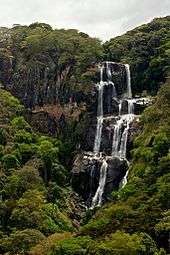Udzungwa Mountains
The Udzungwa Mountains are a mountain range southeast of Dodoma in Tanzania and are part of the Eastern Arc Mountains. They are clad mostly in rainforest and house a biodiverse community of flora and fauna with large numbers of endemic species.
Geology
These mountains, with others in the Eastern Arc, were formed more than one hundred million years ago. About thirty million years ago, the area was covered by extensive rainforest. During a cooler and drier period some ten million years ago, the lowland forests were converted to savanna, leaving the mountain ranges as "islands" where the tropical forests continued to flourish. The isolation of each mountain range has led to a great deal of endemism, and a very diverse flora and fauna.[1]
Flora and fauna
The Udzungwa Mountains are covered with tropical rainforest, mountain forest, miombo woodland, grassland, and steppe. They are home to many large mammals, including the Udzungwa red colobus and Tana River mangabey, and unusual animals such as the grey-faced sengi. The area has extremely high biodiversity with numerous endemic species (more than 25 percent of the vertebrate species).[2] They rise to 2,579 metres (8,461 ft) at Luhombero, and 10 percent of them are protected by the Udzungwa Mountains National Park and the Udzungwa Scarp Forest Reserve. The Udzungwa forest partridge (Xenoperdix udzungwensis) is an endemic species, found only on the Rubeho Mountains and Udzungwa Mountains, with its closest relatives appearing to be the hill partridges of Asia.[1]
Access

It is possible to visit the Udzungwa Mountains National Park and go hiking and trekking. The park has no roads passable by vehicle and is accessible only by foot. The trekking routes vary, from the short and easy one-hour Sonjo Waterfall hike to the extremely difficult 6 day trek the Lumemo Trail. The most popular route is the Sanje Waterfalls trail, taking about four hours to complete. The World Wide Fund for Nature is working with local communities to protect the park and provide conservation and management support, monitoring, research and ecotourism initiatives. The help of the local communities is encouraged by giving them access to resources such as the collection of firewood, harvesting medicinal plants and gathering grass for thatching.[3]
See also
References
- 1 2 Briggs, Philip (2009). Northern Tanzania: The Bradt Safari Guide with Kilimanjaro and Zanzibar. Bradt Travel Guides. pp. 20–21. ISBN 978-1-84162-292-7.
- ↑ Newmark, W. D., 2002, Conserving Biodiversity in East African Forests, a Study of the Eastern Arc Mountains. Ecological Studies 155. Springer-Verlag, Berlin, pp. 197
- ↑ "Udzungwa Mountains National Park, Tanzania". WWF. Retrieved 21 October 2016.
Coordinates: 07°46′S 36°49′E / 7.767°S 36.817°E